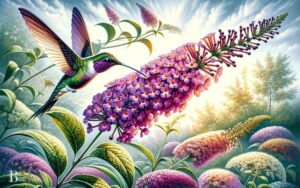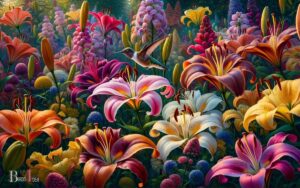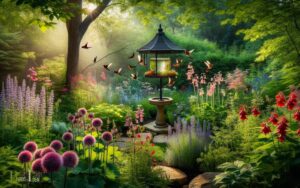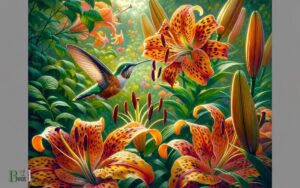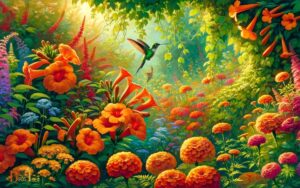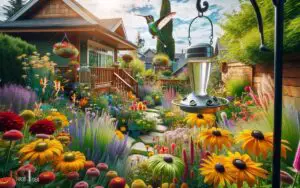Shade Plants That Attract Hummingbirds: Bleeding Heart!
Shade plants that attract hummingbirds typically include varieties that offer ample nectar through tubular flowers. By selecting the right shade-loving plants, gardeners can create a habitat that both beautifies their space and supports local hummingbird populations.
Hummingbirds are attracted to gardens that provide a good source of nectar, which they rely on for energy. While many plants that attract these birds prefer full sun, there are several species well-adapted to shaded conditions.
These plants often have vibrant, tubular flowers that are perfect for the long, narrow beaks of hummingbirds.
Here are a few examples that flourish in the shade:
Incorporating such plants into a shade garden will help in attracting hummingbirds, offering them sustenance, and providing a delightful scene for garden observers.
To attract hummingbirds to your shade garden, choose plants like Bleeding Heart and Fuchsia, which provide the perfect combination of shelter and nectar.
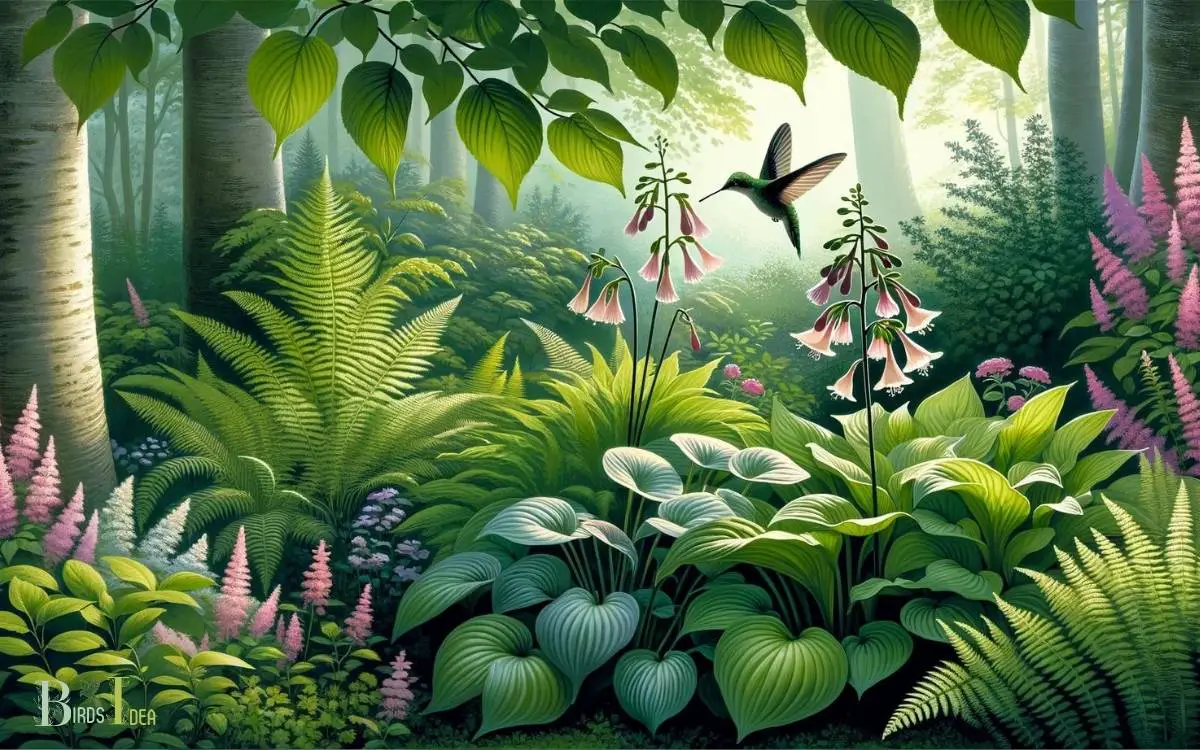
Key Takeaway
Benefits of Shade Plants for Hummingbirds
Attracting hummingbirds, shade plants provide a cool and sheltered environment for these tiny birds to feed and rest. The foliage of shade plants offers protection from the hot sun and predators, making it an inviting space for hummingbirds to explore.
Additionally, shade plants create a natural habitat that mimics the birds’ native environment, encouraging them to visit and stay.
The shelter provided by shade plants also helps to conserve the hummingbirds’ energy, allowing them to rest and refuel before continuing their journey.
Furthermore, the presence of shade plants can contribute to the overall biodiversity of the area, attracting insects and other small creatures that hummingbirds feed on.
Ultimately, shade plants play a crucial role in supporting the well-being of hummingbirds by offering a tranquil and nourishing sanctuary.
Best Shade Plants for Hummingbirds
Shade plants that attract hummingbirds can include a variety of species known for their ability to thrive in low-light conditions. Some of the best shade plants for attracting hummingbirds are coral bells, bleeding hearts, and fuchsia.
- Coral bells, with their delicate bell-shaped flowers, are a favorite of hummingbirds and can thrive in partial shade.
- Bleeding hearts, known for their unique heart-shaped flowers, also attract hummingbirds and do well in shaded areas.
- Fuchsia, with its bright, tubular flowers, is another popular choice for shade gardens and is a magnet for hummingbirds.
These plants not only provide nectar for hummingbirds but also add beauty and color to shaded areas. By incorporating these plants into the garden, one can create an inviting environment for hummingbirds to visit and enjoy.
When designing a hummingbird-friendly shade garden, it’s essential to consider the layout and placement of these plants to maximize their appeal to hummingbirds.
Designing a Hummingbird-Friendly Shade Garden
How can one effectively design a shade garden to maximize its appeal to hummingbirds while taking into consideration the layout and placement of shade plants?
When designing a hummingbird-friendly shade garden, it’s important to create a diverse and layered environment. Start by selecting a variety of shade plants with different blooming periods to ensure a continuous nectar supply.
Place taller plants towards the back of the garden and shorter ones towards the front to create a natural feel and provide hiding spots for the birds.
Incorporate a water feature, such as a small fountain or birdbath, as hummingbirds are attracted to the sound of running water.
Additionally, adding perches like small branches or trellises can provide resting spots for the hummingbirds.
By carefully arranging shade plants and incorporating these elements, one can create an inviting and harmonious environment for hummingbirds.
Attracting Hummingbirds With Shade Plants
Hummingbirds frequently visit shade gardens with an abundance of nectar-rich plants. When selecting shade plants to attract hummingbirds, it’s essential to choose varieties that produce vibrant, tubular flowers rich in nectar.
Below is a table highlighting some shade plants known to attract hummingbirds:
| Plant Name | Flower Color | Blooming Season |
|---|---|---|
| Bleeding Heart | Pink, Red, White | Spring |
| Coral Bells | Red, Pink, White | Spring to Summer |
| Columbine | Red, Pink, Yellow | Spring to Summer |
| Foxglove | Pink, Purple | Spring to Summer |
| Impatiens | Various Colors | Summer to Fall |
Shade Plant Care Tips for Hummingbirds
When caring for shade plants that attract hummingbirds, it’s important to ensure they receive adequate moisture and shade. Hummingbirds are attracted to vibrant blooms, so regular deadheading and pruning will help keep the plants healthy and blooming.
Providing a source of nectar, such as a hummingbird feeder, can supplement their diet and encourage them to visit the shade plants.
Ideal Shade Plants
Attracting hummingbirds to your garden involves selecting shade plants that thrive in low-light conditions while providing nectar-rich flowers.
Ideal shade plants for hummingbirds include coral bells, which produce delicate bell-shaped flowers in various colors, such as pink, red, or white.
Another excellent choice is the bleeding heart plant, known for its unique heart-shaped flowers that hang gracefully from arching stems.
Additionally, the fuchsia plant, with its vibrant, pendulous flowers, is a favorite among hummingbirds. When caring for shade plants, it’s crucial to ensure adequate moisture and well-draining soil.
Regular watering and mulching can help maintain soil moisture, while avoiding over-fertilization is essential to prevent excessive foliage growth at the expense of flower production.
By choosing the right shade plants and providing proper care, gardeners can create a welcoming habitat for hummingbirds in shady areas.
Hummingbird-Friendly Care
Shade plants that attract hummingbirds require proper care to ensure their nectar-rich flowers continue to thrive in low-light conditions. When caring for these plants, it’s important to provide adequate water, as shade gardens can often be cooler and retain moisture.
Regular watering, especially during dry periods, will help to keep the soil consistently moist. Additionally, applying a layer of organic mulch can help retain moisture and regulate soil temperature.
Pruning and deadheading spent flowers will encourage continuous blooming and prevent the plants from diverting energy into seed production.
Fertilizing with a balanced, slow-release fertilizer formulated for shade plants can provide the necessary nutrients for healthy growth and abundant blooms. With proper care, shade plants can create an inviting environment for hummingbirds to visit and enjoy.
Creating a Beautiful Shade Garden for Hummingbirds
While many shade plants can attract hummingbirds, creating a beautiful shade garden for these delightful creatures requires careful selection and placement of flowering plants.
To create an inviting environment for hummingbirds in a shaded area, consider the following:
- Vibrant Flowers: Choose vibrant, nectar-rich flowers such as fuchsia, impatiens, or coral bells to add pops of color to the shaded garden, attracting hummingbirds with their bright blooms.
- Sheltered Spaces: Incorporate shrubs and small trees to create sheltered spaces within the garden where hummingbirds can rest and feel secure.
- Water Features: Include a small water feature, like a birdbath or a gentle fountain, to provide drinking and bathing opportunities for hummingbirds.
- Layered Heights: Plant flowers and foliage at varying heights to create a layered garden, offering different perches and feeding spots for hummingbirds.
Conclusion
Creating a shade garden for hummingbirds can bring joy and beauty to any outdoor space. By choosing the right shade plants and designing a hummingbird-friendly environment, you can attract these delightful creatures and enjoy their presence all season long.
Remember, a shade garden for hummingbirds is like a colorful oasis in your backyard, where these tiny birds can dance and play among the lush foliage. So why not start planning your hummingbird-friendly shade garden today?

